What I Owe to Atila on
My Path to the Counter-Revolution
SOURCE
Below is the transcript of the speech given
by Fr. Paul Sretenovic on January 22, 2017, at the Grand Ball Room of
the Summit House in Fullerton, California. The event was organized to
celebrate the publication of the entire Collection Eli, Eli, Lamma Sabacthani.
Reverend Msgr. Patrick Perez, Fr. Coletti, Sr. Marie Augustine, distinguished guest of honor and my beloved faithful:To say that this is an honor for me to speak today would be an understatement. In 2004 when I was listening to that talk Revolution and Counter Revolution, I said: “I am listening to Atila speak, I will probably never meet him, but he is playing a very important role in my priesthood.” We will see a little bit more about that in a moment.
When I was considering what I was going to speak about today, I said “What can I say? You have heard so much about the Revolution and Counter Revolution. What can I say that you haven’t heard before?” And while I do not want to make this about myself, since this day is certainly not about me, I realized that each of you knows quite a bit about my move to California. You know how I met Msgr. Perez. You know how things went from there. I wrote about it in Catholic Family News, a little bit in The Remnant… so, as I said, you know something.
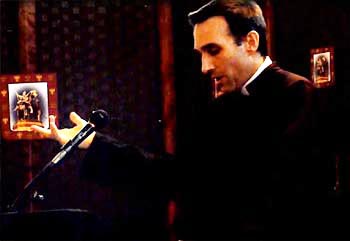
Fr. Paul Sretenovic
During the Christmas Season, especially on certain feasts of Our Lady, we are often reminded of the practice of our Blessed Mother pondering all these things in her heart, these things being things related to the Crucifixion of her Son. So, while I speak now, I recall the fact that, at this time in my formation, I may not as yet have been pondering all these things in my heart, but I was certainly pondering a lot in my mind.
At that time in 1997, I think I was taking theology, starting to take theology classes. I remember my time in the minor seminary years before, it was a time when it was truly a seminary being formed in the womb of Our Lady. I will always look upon the time fondly even though it was Novus Ordo. It was a time of great grace and a time in which I felt especially close to God and the Blessed Mother and St. Therese also.
But once I entered the major seminary in 1997 I felt a certain block. All of a sudden there was a bit of, I don’t want to say a coldness because our vice-rector was very good with me but there was this sense that “Uh oh. I’m not necessarily being formed in the womb of Our Lady anymore.” I figured that I might be formed in some way to be a priest, but it was not going to be what I thought it needed to be.
Questioning Vatican II
When I started taking these classes we started classes on Vatican II, which I had never looked at, not any of the documents, before entering the seminary. So, when they asked me: “What do you think of Vatican II?” I just gave them one line: “Oh, it is great”… Well this was my position when I started attending these classes.
They were going over all the things that were so great about the Council and one of the things had to do with Our Lady, which sounded good. I wondered: How she was relegated to the end of Lumen Gentium? And how was this was really for the best. I questioned about how they debated about calling her the Mother of the Church, how they said it was not really an appropriate title, and I was sitting there listening.
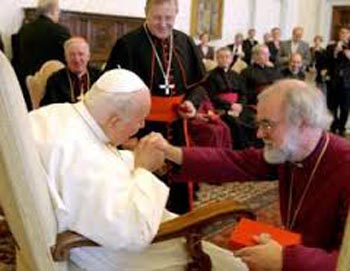
Disastrous consequences of Lumen gentium's application: JPII kisses the ring of Anglican Rowan Williams; below, JPII in the Jewish synagogue of Rome
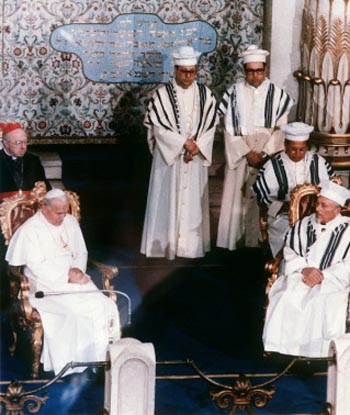
So, I started to think more and more about it and I would hear other things here or there and I would ask: “What is going on here?” At this point, I didn’t think there was anything I could really do about it. I thought I could probably become a priest and would have to complain about these points and maybe say certain things to the people when I could. But I was at that stage in my formation when I was a bit afraid to step out of line.
So, what I did was to start privately to read certain books. The first one was The Rhine Flows Into the Tiber by Fr. Ralph Wiltgen; many of you are familiar with it. And while this was certainly a very good resource, at the same time it was simply like a notary recording the happenings, just notations of the Council: “This happened first, then this happened, then that happened, then another thing happened.”
I said: “Well, this is something!" I was shocked at some of the things I was reading about how the microphone was turned off on Card. Ottaviani because he said traditional things – don’t turn off the microphone, please!. At this point, I was thinking looking at things and thinking: “Well this is a start, but I need something more. I need something that has a broader perspective than simply the notes of the Council.”
So, I found What Went Wrong with Vatican II? by Ralph McInerny; some of you are also familiar with that book. I think the book was in certain ways good. It really helped me to understand the problems with this document or this paragraph. But I was left high and dry by the conclusions, because the conclusion was still “Vatican II was ok” or “there is not any fundamental problem with Vatican II, but just with certain interpretations of certain documents.” The conclusion explains why certain people have a problem, but, ultimately, he concludes that the Council is one of the general ecumenical councils of the Church, so, it cannot be opposed.
Finding In the Murky Waters of Vatican II
I said: “Well, I am in a seminary, I want to be a priest, I really want to believe this but something is missing here.” There was something lacking, something that I knew was not quite correct. So, I prayed a bit and I asked: Is there a book out there that I can get that not only has good theology but also has good conclusions?
And behold I came across the In The Murky Waters of Vatican II [applause] and the first thing I saw was “this is the 1st in an 11-volume series.” I said: “Are you kidding me? 11 volumes?!” I was 24 at that time, so, I wasn’t planning on reading 11 volumes. Maybe I would finish reading it when I would be 60 years old.
But having said this, the second thing I saw – again I was 24-years-old – I saw the name Atila Sinke Guimarães, and I was reminded of – this is a Disney reference now – the hyenas (in the Lion King, if you are familiar with it, you will know what I mean). They were having a discussion about Mufasa [play video below right] who was the present lion king, and one of the hyenas would say “say it again! say it again!” “Mufasa.” I just hear that name and I shudder" [laughter] – so when I saw the name Atila Sinke Guimarães, this just it came to me … this was the depth of my thought at the time. ...
Click to play the scene from The Lion King
I said: “I’ve got to give this book a shot.” So, I did, and I would say, having gone through the book, I would say that if it were the only book and if there were no other book in the entire series, its contribution to the Counter-Revolution would be immeasurable. Even if there was no other, even if the other 10 volumes never got written, this book is so important because it gets to the heart of the problem of Vatican II, out of the mouths and from the pens of the very revolutionaries themselves, what they were proud of. And then when I looked at the conclusion – I knew it was right.
Now, unfortunately, still being young, I did not make the proper conclusions quite yet. Because what I would do is read it, then put it on the shelf and I would forget about it for a while. I would say: “Alright, now back to class; back to the Novus Ordo Mass.” Actually, I was thinking all this even before I was ever considering the Latin Mass. So, it took some more of years for me to come to the proper conclusions.
My favorite part of Murky Waters is the part that sets out the seven stages of the revolutionaries, the progressivists before the Council, then at the Council. How they were very organized but unsure of success. Whereas the traditionalists, the conservatives, they had no plan but they were confident that everything was going to be fine, because of the original schemata that was there before the Council.
Reading and re-reading those seven points. I said: “if this was all that was in the book, it was worth the price of the book” because it gives in a nutshell exactly what happened, how they kept switching their masks to bring about the Revolution. Whatever was the most opportune thing to do at the time, they did. And how the counter-revolutionaries, well not the real counter-revolutionaries but the otherwise traditionalists at that time, just never quite got it and just didn’t do enough to oppose it.
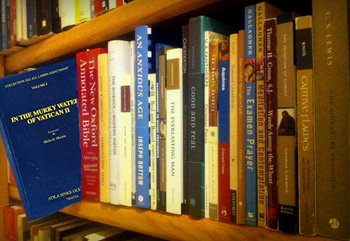
On my bookshelf - to the horror of other seminarians
I was pondering things over in my mind at the time. I said to myself, “I don’t think it is right, but I know he is right that I could get in trouble for having it.” But I never did. I kept it on the shelf and I never had a problem. The vice-rector could make certain visits every so often, but I never got in trouble.
I remember I just put it back on the shelf and I told my friend: “You know what? No, everything will be fine.” This was one of the few really conservative seminarians and his first concern there was fear of what people could say based on what is written there or what I would have on my shelf: I thought: “There is something really not quite right about that. Maybe there is something that I can do.” And, of course, it actually took more time to go from my head to my heart, but still, they say the greatest distance is from the head to the heart.
I got this same reaction from different people also. I would find this attitude in the seminarians who were most like-minded with me. They would say, “Oh, the Latin Mass, the Mass of Trent, it is just aesthetics." These are the kind of things I would hear. Even the vice-rector would say that kind of thing.
So, making a long story short, as time went on, even though I had to suppress it; because my will was not ready to do anything, but even though I wasn’t quite ready, I had a sense that at some point something was going to happen. I knew this because we went to Rome and everybody had a picture with Pope John Paul II except me [laughter]. I got separated from the group. A year or two later I thought: “What’s going on here?”
So, I was not looking too much into it, but at the same time there were little things – I’d read different conservative pieces defending the Novus Ordo and think: “This is not right” or “that’s not right.” All of a sudden, finally, in 2004, I realized, after listening to that “Revolution and Counter-Revolution” tape on my way to Pittsburgh to pick up a brother who was a Benedictine, something clicked. But even then I still needed Msgr. Perez' help here, I still needed Fr. Smith's help at the time and eventually finally I did what I should.
The crucial role of the laity
If I had to sum up my experience during this time as I look back now, one thought strikes me. It’s that at for all of those years, it was the priests who were the ones who were supposed to be forming the seminarians, but when I look back it was, by and large, the laity that played the greatest role, the biggest role, in my conversion to Tradition. Not exclusively, of course, there was Monsignor and others like Fr. Smith who helped me.
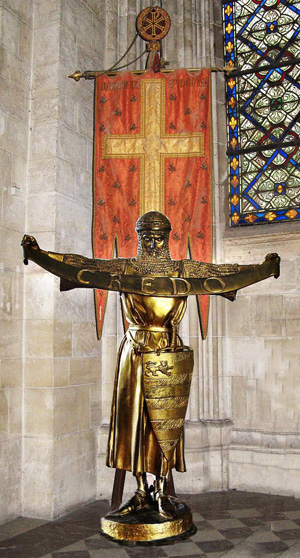
An invitation to join the fight of our epoch
I am eternally indebted to you, Atila, for everything you have done, and not just for the Murky Waters. I moved to California I went there to the TIA office, I saw them all working there, translating and doing everything. So, in conclusion, I will just say there is no coincidence in a way that I was helped so much by a laymen here and others of the laity.
The doctrine of St. Louis de Montfort is that in the end times Our Lady would use her heel to crush the head of the serpent. And that heel is made up of the faithful. Certainly priests, and some bishops maybe will be part of it too, but it is mostly and especially made of the lay shock troops, to borrow a term from Dom Chautard [in The Soul of the Apostolate].
It was the case in the time of the Arian crisis, as it was in the case in the Revolution in England, and now in these times it is you – all of you here – because you are called to the Counter-Revolution and because you are already in some way a part of it. I would just encourage you to continue to fight. Fight against your own corrupt nature: we all have this that we carry with us everywhere we go. But do not just be concerned with the spiritual life, you must also lead the life of the counter-revolutionary which is based and steeped in doctrine.
And, with this, I have the pleasure to introduce to you one who has been the leader of this Counter- Revolution, one of the great leaders in this fundamentally Marian mission in which the head of the serpent will be crushed as it was in the beginning of time. I introduce to you, then, that man whose books I read and then would say “ok, but I’ll never know him.” But I did meet him, I do know him, and he helped me to ponder in my mind and now more in my heart what it means to be a counter-revolutionary. So. I count him as a mentor, as a friend, Mr. Atila Sinke Guimarães.
